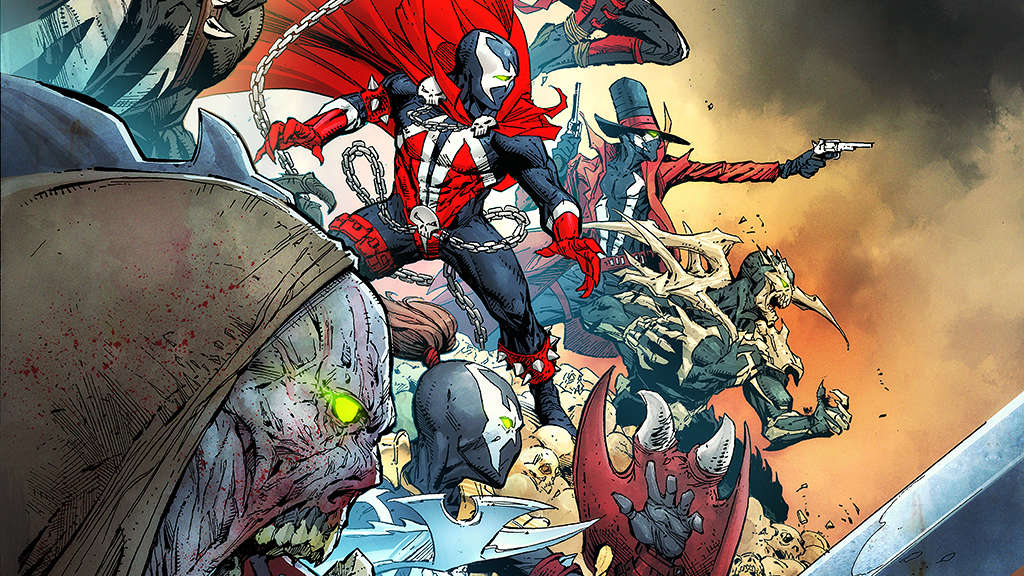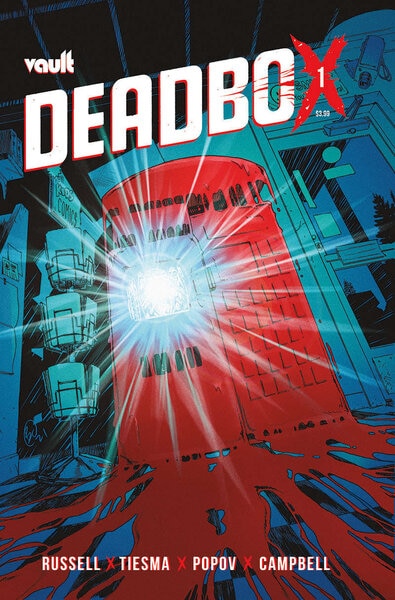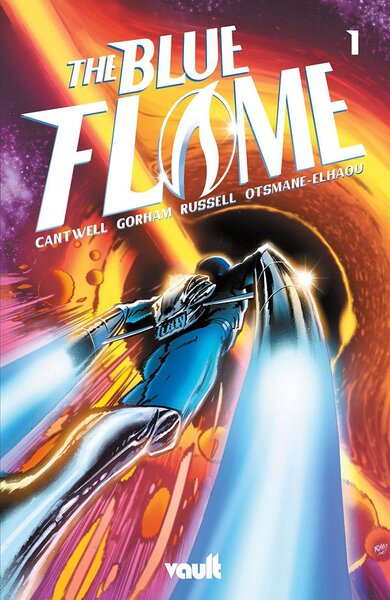Create a free profile to get unlimited access to exclusive videos, sweepstakes, and more!
Comics Wire: The shared universe boom, DC's Infinite Frontier, Ta-Nehisi Coates' final Black Panther & more

Welcome to Comics Wire, SYFY WIRE's weekly comics column that gets at the pulse of what's going on in comics right now. We've got what you need to know about huge crossovers, real-life issues facing the industry, cool first looks, the week's hot new comics, and everything in-between.
If you love comics, there's a very good chance one of the things you love about them is the idea of shared universe storytelling. The superhero narratives primarily associated with the medium in American pop culture are packed with it, and they have been for decades. There's nothing quite like that childhood thrill of understanding that Spider-Man and Captain America can hang out and do stuff together, or that Batman and Superman are actually friends, and it's a thrill we've now seen translated to everything from ultra-ambitious comics crossovers to video games to billion-dollar movies.
The shared universe model of storytelling is arguably more popular than ever, and not just when it comes to superhero stories. Film and television franchises are picking it up in more and more genres, and though they don't always succeed, the ambition seems to persist. It persists to such a degree, in fact, that we're starting to see an exciting and fascinating new boom of shared universe storytelling within comics publishing outside of the traditional Big Two world.
Other non-Big Two shared universes exist, of course. Various Image Comics titles have made a run at it (Wildstorm was an Image imprint before it was grafted onto the DC Comics world), Valiant's going strong, and Mike Mignola and company have been steadily building a Hellboy universe with decades of continuity and characters since the 1990s. No one is necessarily reinventing this particular wheel, but what does seem to be happening is the rise of a new wave of creators who see potential in the idea of linking books and stories together in the comics world at a time when interconnectivity is becoming more and more prized across various fandoms.
For months now, Image co-founder Todd McFarlane has been hyping what he's dubbed "Spawn's Universe," a shared world of titles and characters with the acknowledged goal of one day becoming so vast that it outgrows Spawn and his various supporting players. But McFarlane is far from alone in his ambitions right now. Kyle Higgins and Mat Groom are building a tokusatsu homage-laden world with the already launched Radiant Black and the recently Kickstartered Inferno Girl Red, both of which promise to provide new spins on both the tokusatsu genre and superheroes at large. At Dark Horse, Black Hammer creators Jeff Lemire and Dean Ormston are letting a progressively larger group of creators into their world through a combination of anthologies and new spinoff series. Elsewhere at Image Comics, The Old Guard creators Greg Rucka and Leandro Fernandez have begun spinning off anthology stories based on their core characters, while just days ago The Silver Coin creator Michael Walsh announced that what was once a horror miniseries set in a shared world will now expand to an ongoing title with an even larger roster of top tier writers contributing tales to its ever-expanding web.
And of course, it doesn't end there. There are the ongoing sagas of The Sandman Universe, Buffy the Vampire Slayer, Teenage Mutant Ninja Turtles, Transformers, Star Trek and countless other licensed properties unfolding at various publishers, along with other new stories just beginning to take root in the industry with the promise of various branching tales if they have the readership to sustain them. And that, of course, is the key question here. Readership. People show up for the Big Two universes because of the brand and the longevity, but how regularly will they turn out for an expanding line of titles unconnected to any previously established IP?
How far can indie creators go with their titles as the continuity webs they weave get ever more complex? It's not an easy question to answer, particularly when you get into the economics of trying to keep ongoing series afloat in the creator-owned world, but what's important in my mind right now is the sense of ambition that feels like it's permeating comics right now. People are building grand scaffoldings on which they can hang the work of years, and that gets me excited, even if some of them are destined to fall. I'm eager to explore more universes beyond those beloved Big Two, and I hope these creators keep putting them together, one panel at a time.
DC preps for Infinite Frontier
Next month, the next big event in DC Comics will finally rollout with the launch of Infinite Frontier #1 from writer Joshua Williamson and artist Xermanico. If it feels like it's been a bit of a long time coming, that's perhaps DC has given us a little time to settle into what's been billed as the "Infinite Frontier Era" of the universe after the one-two punch of Dark Nights: Death Metal and Future State and the primer that was Infinite Frontier #0. Now, with the miniseries proper just weeks away, DC has revealed more about what to expect in the series to come, and there are perhaps more than a few surprises in store.
For those of you who may have missed the setup, Infinite Frontier follows the heroic victory over Perpetua at the end of Death Metal which restored…well, just about everything in DC Comics continuity. We're not just talking about 52 universes in a multiverse anymore. We're talking about an Omniverse packed with heroes and potentially futures, still spinning out more universes and more possibilities and simultaneously restoring various key figures in DC Comics to the main timeline. That means that Infinite Frontier is going to deal with some perhaps unexpected major players like, for example, Alan Scott, the original Green Lantern, who has to deal with both missing teammates and the apparent abduction of his daughter, Jade.
Then there's Roy Harper, aka Arsenal, who was supposed to be dead but is apparently very much alive and dealing with some strange new abilities. Oh, and as the covers in the gallery above reveal, the miniseries will also feature multiversal major players like President Superman and Thomas Wayne, the Batman of the Flashpoint universe. It's a lot to juggle, but considering the magic Williamson was able to work with his run on The Flash, I'm very excited to see how he pulls it all together.
What role do these characters and more have to play? How will it all resolve? What did that Darkseid tease back in Infinite Frontier #0 mean? We'll find out when Infinite Frontier #1 launches June 22. For more on the miniseries, including a look at additional variant covers, head over to DC's website, and check out Williamson's rather enthusiastic tweets on the subject.
More news: Deadbox at Vault, Echolands at Image, and more!
- Any time Mark Russell decides to launch a new high-concept comics series is a time worth celebrating, and late last week Vault Comics revealed his next big idea, a collaboration with artist Benjamin Tiesma called Deadbox. What's Deadbox about? Why, it's about a cursed DVD rental machine in a small town, of course. In Vault's announcement for the series, Russell noted that while the new horror story leads off with a frankly incredible pun, it's also a deeply personal book about what it feels like to watch the town you grow up in morph into a place you don't recognize, and if Russell's past work is any indication, he'll be able to balance that emotional weight with some truly wild genre concepts. Deadbox #1 arrives in August, and I'll be ready to devour it as soon as possible. For more on the series, head over to Vault's website.
- Way back in Marvel Comics #100 two years ago, writer Al Ewing teased something big, something helped along by another tease from Marvel earlier this year. Now, thanks to Newsarama, we finally know what it is. In celebration of 50 years of Marvel's strangest super-team, Ewing and artist Javier Rodriguez are reviving The Defenders this August for a new five-issue series billed as a cosmos-colliding journey starring characters like Doctor Strange, Silver Surfer, and the mysterious Masked Raider. Ewing's one of those writers who seems primed to knock this out of the park, and I'll definitely be ready to read it when it launches August 11.
- Over at Image late last week, the Batwoman creative team of J.H. Williams III and W. Haden Blackman unveiled Echolands, a genre project a decade in the making that looks like a stunning new chapter in their collaboration. Unfolding in a landscape format that seems perfectly suited to Williams' always incredible art, the book is set in a "bizarre future world" in which a thief who holds the key to the past must outsmart a "tyrannical wizard." I'm in already. Echolands #1 arrives August 25, and you can check out some gorgeous pages from the issue at Image's website right now.
- And finally this week, the folks over at Z2 Comics have been putting out incredible, ambitious music-themed comics for a while now, but they may have outdone themselves this time. The publisher just announced Freddie Mercury: Lover of Life, Singer of Songs, an exploration of the legendary Queen frontman's life written by Tres Dean (All Time Low: Young Renegades) with art from an amazing lineup that includes Kyla Smith, Robin Richardson, Safiya Zerrougui, Tammy Wang, and Amy Liu. It's available for pre-order right now in a typically stunning Z2 format, and if you're a Queen fan you're going to want to check it out.
Comics this week: The Blue Flame, Made in Korea, Mister Miracle, and more!
That's the news. Now let's talk about some of the comics I got excited about this week.
The Blue Flame #1: After writing some of the best comics in Marvel's lineup for the past few years, Christopher Cantwell set out to craft a superhero universe all his own alongside co-creator and artist Adam Gorham. The result is The Blue Flame, an intriguing blend of down-to-Earth and cosmic-level concerns that all comes together into one of the best first issues of the year so far.
The Blue Flame of the title is Sam Brausam, a man who is depicted in various phases of this stunning debut issue as a cosmic-level hero soaring across galaxies, a street-level vigilante patrolling Milwaukee with his own DIY league of fellow do-gooders, and an HVAC repairman just trying to put in a day's work.
If it sounds like a lot to contain in one issue of comics, that's because it is, but the great gift of Cantwell and Gorham's collaboration here is that The Blue Flame #1 never feels overloaded. Instead it feels ambitious, expansive, simultaneously obsessed with both the micro and the macro of the superhero life. That's reflected in Gorham's instantly memorable designs and art, which are capable of simultaneously evoking the most expansive cosmic vistas of The Green Lantern and the most intimate, grounded moments of books like Fraction and Aja's Hawkeye. It's also there in Cantwell's script, which is both luxuriously layered with big ideas and rich with character detail.
It doesn't feel like the beginning of a new superhero world. It feels like a world that was already there, alive and vibrant and powerful, and that Cantwell and Gorham have simply opened a portal to allow us a peek. The Blue Flame #1 is a triumph, and if the first issue is any indication, this is a series we'll be talking about for a long time.
Made in Korea #1: I love stories that are able to deposit you right in the middle of a richly realized world without ever necessarily taking your hand and guiding you through the world at large. You meet some characters, you learn their desires and motivations, and context clues and design work do the rest. That's the experience of Made in Korea #1, the first issue of the new sci-fi miniseries from writer Jeremy Holt and artist George Schall, and it's an immediately and thrillingly rewarding read.
Inspired by Holt's own experiences as an adoptee, the book lays out two prongs of an intimate story told against the backdrop of a near-future world in which artificial children known as "proxies" are available for purchase to an increasing number of parents who can't have kids of their own. Through a deftly structured, remarkably incisive script, Holt introduces us to a new and unusual proxy through two narratives unfolding on opposite sides of an ocean, as we meet both a programmer looking for a breakthrough and a couple in Texas struggling to afford a proxy of their own. In the middle is Jesse, a still-mysterious proxy who's unlike anyone else of her kind.
What's clear right away -- thanks to both Holt's writing and Schall's clean, brilliantly expressive panels -- is that this is not just a sci-fi story dealing in high-concept questions about the nature of existence. This is a tense, emotional, very human narrative about the connections we make, the value they have, and the way the wider world sees them. It's a comic packed with heart and ambition, and I'm eager to see where it goes.
Mister Miracle: The Source of Freedom #1: Shilo Norman, the third Mister Miracle, is one of those DC characters I'm always happy to see more of, so I was eager to pick up the first issue of writer Brandon Easton and artist Fico Ossio's new miniseries The Source of Freedom, which focuses on Shilo's place as the "Mister Miracle of Tomorrow" and begins with a first issue that's full of promise.
The line between superhero and celebrity has long been a part of the Mister Miracle dynamic through both Shilo's story and Scott Free's, but here Easton and Ossio make it an even bigger focus in a world where Shilo is the face of a global brand dedicated to all things Miracle. Except he's not the face of it. Mister Miracle is, because Shilo is convinced that revealing who he really is at this point in history would cripple the Miracle brand and his own confidence forever.
It's that hesitancy, that sense of using the superhero mantle not as a personal burden, but a personal crutch, that makes this story particularly fascinating. Easton's script sells that sense of duality immediately, as we see the different ways in which the Mister Miracle persona and Shilo Norman's own life dance around each other. It also comes through in Ossio's dynamic pencil work, which is able to show us both the shared physicality of Shilo Norman and the super escape artist he embodies, and the ways in which Shilo seems to shrink from the world when the subject of his dual identity comes into play. Fun, tight, and packed with big ideas, this is a series I'm eager to keep an eye on, because it really does seem to prime Shilo for bigger things in the DC Universe, something the character has long deserved.
Redshift #1: A lot of genre stories with lofty conceptual ideas spend the entire first issue explaining the concept at hand. That's not a bad thing, but it often means that a lot of the emotional payoff of the story has to wait until future issues. With all that in mind, it's always a joy to find a book that manages to launch an ambitious sci-fi narrative with big conceptual goals while also layering plenty of emotion in from the beginning. Redshift, the new series from writer H.S. Tak and artist Brent McKee, is that kind of book, and I was instantly hooked.
The book begins on Mars, where humanity is busy mining ice for survival and looking to the stars for the next great Earth-like world to call home. To make that happen, leaders periodically select "voyagers," intrepid humans meant to travel vast distances in search of a new habitable planet. It's within that conceptual space that Tak and McKee introduce us to the Drake family, who've already sacrificed one member to the voyager program, and may be called upon to send another.
McKee's art navigates this sci-fi landscape with energy and precision, illustrating the doldrums of Martian life and the thrill of the voyager program with equal power as Tak's script lays out not a vast sci-fi narrative, but a story about family contained within the sci-fi ambition. Right away we can sense the emotional stakes of every member of the Drake family, and as the story begins to shift by the end of the issue to set up what's next, we're catapulted right along with them into new territory. The result is a thrilling debut packed with potential.
Black Panther #25: I'm not sure what I could write about the epic Ta-Nehisi Coates era of Black Panther that hasn't already been written, but Coates' run on the book concludes this week, and it feels strange not to pause for a moment and remark upon something that has been, in every sense of the word, remarkable. When Coates took over this superhero title, he was known primarily for nonfiction commentary and memoir, not necessarily for building vast comic book worlds upon which a generation of new storytellers can build their own narratives in years to come. Five years on, Coates has become one of the brightest minds in superhero storytelling right now, and he's got a Superman movie deal to prove it.
Ever since he was first introduced in the pages of Fantastic Four, Black Panther has been an imminently versatile character in the Marvel arsenal, a figure just as at home in wild sci-fi epics and mystical journeys as he is in intimate stories about social justice and the nature of power. Coates' run, bolstered by incredible art from both Brian Stelfreeze and Daniel Acuna (who return to tag team this epic final issue), managed to be all of the above, lost none of its power in breaks between issues, and culminates this week with a lyrical, emotional, triumphant finale that leaves plenty of material for future storytellers to build and meditate on. Bravo to the entire Black Panther creative team on sticking this landing.
And that's it for Comics Wire this week. Until next time, remember what John Custer told his son Jesse in the pages of Preacher:
"You gotta be one of the good guys, son: 'Cause there's way too many of the bad."




























